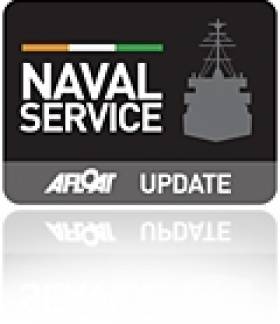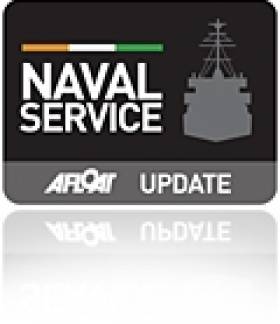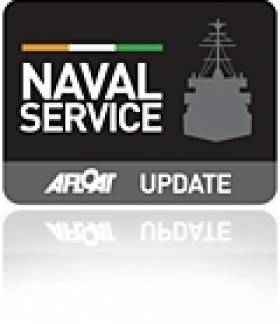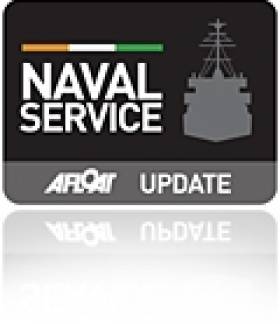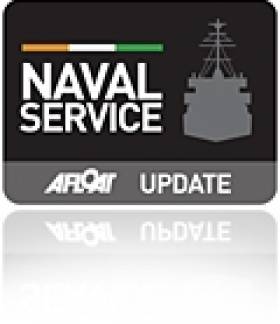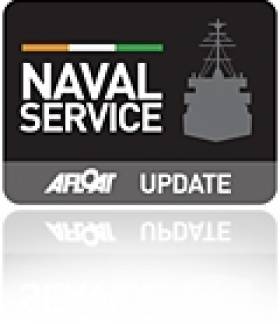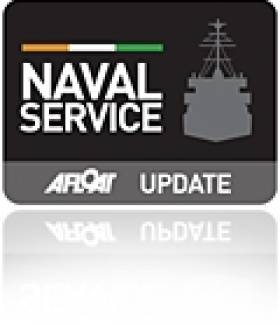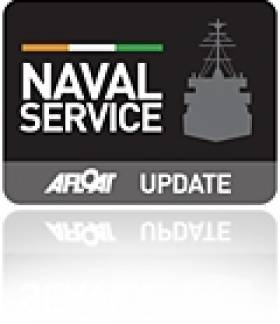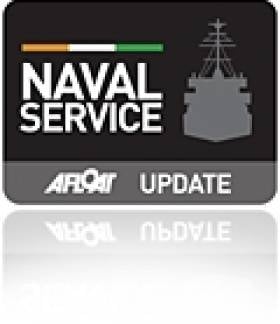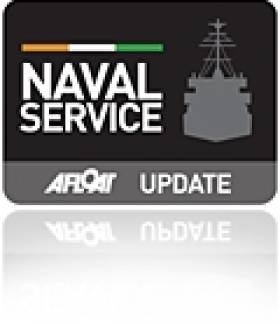Displaying items by tag: naval service
L.É. Aoife Only Days Before Decommissioning
#Decommission - L.É Aoife (P22), the Naval Service's oldest vessel as previously reported on Afloat.ie is on her last patrol before decommissioning with a date now confirmed for next Saturday 31 January, writes Jehan Ashmore.
Waterford City is where the Verolme Cork Dockyard built offshore patrol vessel (OPV) will be decommissioned ceremonially. The choice of location is apt given that L.É Aoife's adopted homeport is that of the inland south-eastern city-port.
She was launched in 1978 following leadship class 'Emer' an improved version of L.É Deirdre, long since sold. The 65m OPV was named Aoife, stepmother to the children of Lir, whom she turned into swans. She entered the Naval Service when commissioned in November 1979.
A timeframe, for the OPV's disposal through a public auction (if not previously sold) remains to be confirmed according to the Department of Defence spokesperson. However, the auctioneer's website still suggests otherwise with an auction date to be held sometime in February, for details and further updates, click HERE.
Yesterday, L.É Aoife departed Cork Harbour from where the navy's pair of coastal patrol vessels CPV's as reported on Afloat.ie have been out of service due to work to remove asbestos.
As for the direct replacement of L.É Aoife, newbuild, James Joyce is understood to be scheduled to carry out sea acceptance trials in mid-February.
She is the second of a trio of OPV90 class 'Beckett' newbuilds totalling €162m that have been ordered in a contract to Babcock Marine's Devon shipyard in Appledore.
Naval Service Patrol Vessels Undergo €350,000 Asbestos Removal Works
#Asbestos- A Department of Defence spokesperson has confirmed to Afloat.ie, that the Naval Service pair of coastal patrol vessels (CPV) have been cleared of airborne asbestos and that the dangerous material was in engine room spaces, writes Jehan Ashmore.
As previously reported on Afloat.ie, the hazardous asbestos was discovered last year on board the CPV L.É Ciara (P42), which led to claims over health concerns to her crew and civilians workers.
The overall cost of the asbestos clearance which includes her sister L.É Orla (P41) is according to the Department to be in the region of €350,000 and not the speculated €1m as reported by Ships Monthly.
The sisters were given the all-clear for asbestos back in 2000, following a survey conducted by a now defunct consultancy firm.
In addition according to the UK publication, the asbestos in the engine room was used for lagging purposes by shipbuildersin 1984, Hall Russell & Co of Aberdeen (since closed) which completed the pair for the Royal Navy as part of a larger order.
Four years later the 'Peacock' class twins that served the RN's Hong Kong Patrol Squadron where transferred to the Naval Service in 1988. That same year, I recall making a visit to board the CPVs which had recently arrived in the naval basin in Cork Harbour, where they moored abreast.
In the following year, An Taoiseach Charles J. Haughey officially commissioned them into service.
The Department of Defence have also informed Afloat.ie that the 'Orla' the former HMS Swift (P241) and 'Ciara' as the Swallow (P242) are currently having remedial work done on the funnels, cranes and air-handling units.
In addition the CPV's have undergone a "normal" refit work, which was carried out at Cork Dockyard and the department added to Afloat.ie, that the maintenance dry-docking was scheduled before the asbestos issue arose.
The vessels are also understood to have returned today (or early February) to the Naval Base on Haulbowline Island, from where further work is to continue.
At present, L.É Orla is scheduled to undergo sea acceptance testing in mid-February and it is expected that L.É Ciara will follow suit when available in March.
Bid by Elite Seamen to Pass Gruelling Naval Diving Test
#EliteDiving - As the country was battening down the hatches and ducking for cover this week, 10 hardy hopefuls took to the icy waters of Cork harbour, writes The Irish Mirror.
Standing to attention in gale force winds on Haulbowline Pier, this wasn't some cheap TV reality series designed to make us all feel fat.
There were no camera-friendly emotional breakdowns or interesting back stories.
No, these are the elite seamen vying for a coveted place on the Naval Services Diving Section.
What awaits those who succeed is not fame and fortune. Instead they will be expected to leave important family events at a moment's notice to recover bodies or tackle dangerous underwater bombs.
Each year around 50 people apply and roughly 15 of these are selected for the gruelling 11-week course.
For much more on this story, click HERE.
L.É. Aoife Carrying Out Final Patrol to End This January
,#FinalPatrol - L.É. Aoife (P22) the oldest Naval Service vessel is currently on her final patrol before she bows out of her career, which is expected to end within the final week of January, writes Jehan Ashmore.
Afloat.ie has contacted the Department of Defence which at this stage cannot confirm details of her official decommissioning. A Naval Service source, however, suggests that she may be decommissioned ceremonially also later this month, in Waterford, her adopted homeport.
Following that, a timeframe for the OPV’s disposal by public auction (if not previously sold) is understood to be held in either late February or early March, though this remains to be confirmed.
The OPV built at Verolme Cork Dockyard is the second of a trio of 'Emer' class sisters. They were an improved version of the original ‘Deirdre’ class launched in 1972 and also completed by the same shipyard.
As for the removal of her armaments, the Department of Defence said these matters are being considered as part of the decommissioning process.
Viewings of the L.É. Aoife, can be made strictly by appointment only, to contact Dominic J. Daly call on 087 2550486 and for further developments, click the auctioneer's website, HERE.
Directly replacing the veteran vessel is the OPV90 class newbuild, L.É. James Joyce, which as previously reported is the second of the trio of ‘Beckett’ class ordered from Babcock Marine.
She was floated-out last November at their shipyard facility in Appledore, north Devon.
Naval Service Carry Out 900 Boardings in 2014
#NavalBoardings – More than 900 boarding's have been carried by the Naval Service so far in 2014.
In addition this year saw a total of 10 detentions for alleged infringements of fishing regulations during the 940 patrol days conducted by the fleet of eight vessels. Joining the fleet was newbuild OPV L.E. Samuel Beckett (P61) which entered service in May.
Infringements recorded during inspections on board a total of 31 fishing vessels ranged from incorrect boarding equipment to under recording of catch. These fishery infringements resulted in points being awarded against each vessel.
Such searches and detentions of vessels take place in a sea area that requires the Naval Service to patrols 1 million km2 of sea. The massive patrol zone equate to over twelve times the land mass of Ireland, representing 15% of Europe's fisheries.
Asides Irish and neighbouring UK fishing vessels boarded and inspected by the Naval Service, the following list of countries have also been with vessels from Belgium, Netherlands, France, Spain, Germany, Norway, Denmark, Russia, Lithuania, Faroe Islands, Portugal. Also fishing vessels from as far as Mauritania in west Africa are part of this international fleet.
As part of fishery duties the Naval Service operates the National Fisheries Monitoring Centre and strives hand in hand with the Sea Fisheries Protection Agency.
Combined these agencies are to safeguard and manage our rich fisheries for current and future generations' sustainable exploitation.
The Naval Service with the Air Corps assist the Ordnance Survey Ireland (OSI) in Base Lines Project to map Ireland's sovereign claim to the seas around our island for generations to come.
Warship Navigation Systems Contract Signing with Naval Service
#SoftwareContract - OSI Maritime Systems (OSI) has announced the signing of a contract with the Naval Service to deliver warship navigation systems, writes the Maritime Executive.com
The contract includes OSI's ECPINS-W (Warship) software and under the terms of the deal OSI will provide engineering services, ship systems, operator training systems, and installation services.
In addition the company will install the systems throughout the entire Naval Service fleet.
According to the contractor, ECPINS-W is the only software certified by an International Association of Classification Societies approved body against the NATO WECDIS STANAG 4564.
L.E. Aoife to Be Auctioned in February 2015
#AoifeAuction – L.E. Aoife (P22) the Naval Service's oldest OPV unit has finally been given a timeframe for its disposal by public auction (if not previously sold) in February 2015, writes Jehan Ashmore.
According to Cork based auctioneers, Dominic J. Daly, they have been instructed by the Department of Defence to dispose of the offshore patrol vessel which entered service in November 1979. She was built at Verolme Cork Dockyard as the second of a trio of 'Emer' class sisters.
As previously reported on Afloat.ie, the OPV was originally scheduled to be disposed of last October, a year after the sale by auction of L.E. Emer to Nigerian interests.
The delay on disposal as previously reported on Afloat.ie hinged on the progress in constructing her replacement the newbuild OPV 90 class James Joyce which in recent days was floated-out at Babcock Marine's shipyard in Devon.
Viewings of the L.E. Aoife can be made strictly by appointment only by contacting the auctioneer on 087 2550486 and for more info click HERE.
The newbuild OPV90 class James Joyce is expected to be delivered to the Naval Service in early 2015.
#AoifeAuctionUpdate – L.É. Emer (P21) which was sold at public auction this day last year to Nigerian interests for €320,000, was to be followed 12 months later with the disposal of sister L.É. Aoife (P22) however this has been postponed, writes Jehan Ashmore.
Commenting to Afloat.ie as to the decision to defer the auction date this autumn, the Naval Service said that they are planning for the decommissioning process of L.É. Aoife. However, no firm date has been set for this event which will be dependent on progress made on the build of the L.É. James Joyce. It is the responsibility of the Department of Defence reference the sale of L.É. Aoife thereafter.
In the meantime L.É. Aoife, the second of the trio of 'Emer' class OPV's is undergoing dry-docking at Cork Dockyard Ltd. The shiprepair site at Rushbrooke was the former Verolme Cork Dockyard which completed the 1,019 tonnes displacement vessel for the Naval Service. She was commissioned 35 years ago when she joined the naval fleet on the 29 November 1979.
Cork based auctioneer Dominic J. Daly sold the leadship L.É. Emer to Uniglobe Group, however she remained in Cork Dockyard for work to prepare her new role and departed during this summer.
The auction of L.É. Aoife is part of a programme to replace the ageing series. Her successor L.É. James Joyce is the second of three OPV90 or so called 'Beckett' class on order from Babcock Marine in the UK.
When L.É. Aoife is eventually sold this will leave L.É. Aisling (P23) as the final unit to be disposed. She will be replaced by a third newbuild again costing €54m and due for delivery in 2016.
Naval Service Reserve Passing Out Ceremony At Haulbowline
#navy – Ten new recruits to the Naval Service Reserve completed their training in a ceremony in the Naval Base on Haulbowline yesterday. The 10 recruits, 9 from Cork and 1 from Dublin endured 3 weeks of intense training where they covered a range of subjects such as foot and arms drill, marksmanship, sea survival, fire-fighting, military law and an introduction to military customs, traditions and way of life.
This is a milestone as it marks the first integrated Naval Service Reserve recruit class since the inception of the Single Force Concept which is a key element of the 2012 Defence Forces Reorganisation. The training was shared between members Naval College and the Naval Service Reserve. The Naval Service Reserve will soon be seeking a total of 25 potential recruits in its Cork (2), Dublin (5), Limerick (8) and Waterford (10) units.
The role of the NSR is to augment Naval Service seagoing strength through provision of trained personnel whilst at unit level providing the capability for an armed Naval Element afloat with local shore support and expert local maritime knowledge and intelligence in support of PDF Operations at and from the sea in the main trading ports in support of maintenance of National Sea Lines of Communication (SLOC).
The Naval Service is an integral part of Óglaigh na hÉireann / Defence Forces and operates jointly with the Army and Air Corps. The Naval Service protects Ireland's interests at and from the sea. Currently, the Naval Service is tasked with a broad range of maritime defence, security and other roles. Routine patrols are multi-tasked to encompass national and maritime security, ocean governance, fishery protection, safety and surveillance, port security, drug interdiction, pollution control and search and rescue.
The Service also supports Army operations in the littoral and by sea lift. It provides support on Aid to the Civil Power and Aid to the Civil Authority operations, including inter alia maritime security cordons, and possesses the primary diving team in the State. The Fisheries Monitoring Centre ( FMC) at the Naval Base is the designated national centre with responsibility for monitoring all fishing activity within the Irish Exclusive Fishery Limits and all Irish fishing vessels operating around the world. In addition, Naval Service Vessels have undertaken supply and reconnaissance missions to overseas peace support operations and participated in foreign visits in support of Irish Trade and Diplomacy.
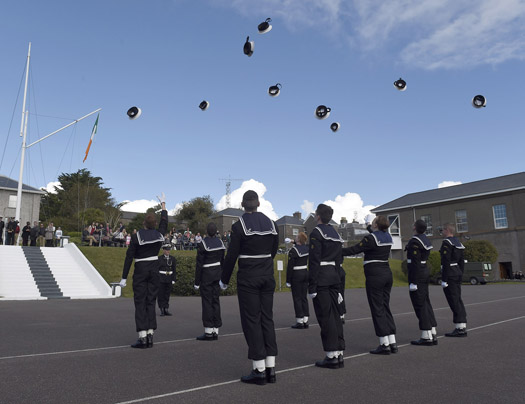
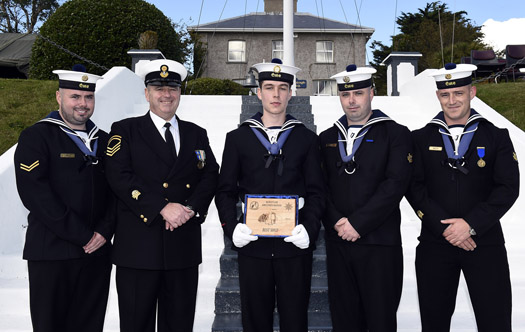
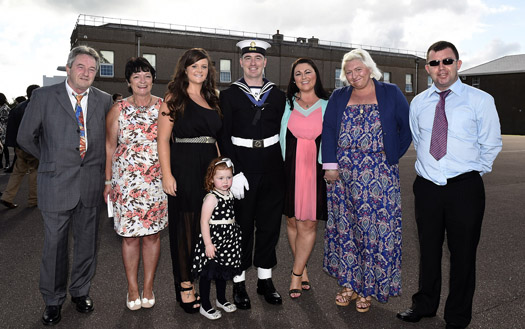
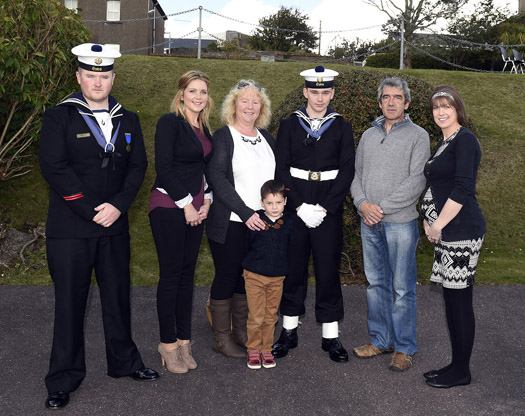
Naval Service Showcase L.E. Samuel Beckett at OPV Conference
#OPVconference- L.E. Samuel Beckett (P61) is appropriately docked in Dublin Port, having arrived last night on the eve of today's start of the International Offshore Patrol Vessels Conference (30 Sept-2 Oct) held in the capital, writes Jehan Ashmore.
The €54m OPV90 class newbuild of 2,226 tonnes is berthed alongside Sir John Rogersons Quay, where a ceremony as previously reported saw her christened and commissioned into the Naval Service in May.
As the class name suggests, the OPV is 90 metres in length, which is 10 metres longer than her predecessor, L.E. Niamh (P52) the second of a pair of 'Roisin' class built for the Naval Service 12 years ago in Appledore, north Devon by Appledore Shipbuilders. The yard is now owned by Babcock Marine & Technology, one of several such facilities in the UK which forms part of Babcock International.
L.E. Samuel Beckett has a crew of 44 though this can be extended to accommodate ten more for cadet trainees. As for her main weapon, this is a OTO Melera 76mm compact gun mounted on the bow, two 20mm Rheinmetall cannon guns located on either side of the funnel casing and elsewhere four smaller machine guns. Engine power is from a pair of 6 cylinder Wartsila diesel motors driving twin shafts that propel a top speed of 23 knots.
Her presence along the Liffey's city centre quays represents the latest in OPV design. From next year she is to feature (UAV) Unmanned Aerial Vehicles for surveillenace purposes as required for the role of the naval branch of the Irish Defence Forces which is in association partnering the major three-day OPV conference.
Among the speakers from the more than 20 nations representing OPV industry stakeholders, navies and shipyards is Andrew Hamilton, head of Babcock International. The same north Devon yard that built L.E. Samuel Beckett, is where her sister L.E. James Joyce is currently under construction as part of an original order for the pair. She is due for completion in the first quarter of 2015.
Last June, the Department of Defence took up the option of ordering a third OPV90 or 'Beckett' class sister from the yard for the fixed price of €54m based on 2012 prices. The yet to be revealed name given for the final member of the class is due for delivery in 2016.


























